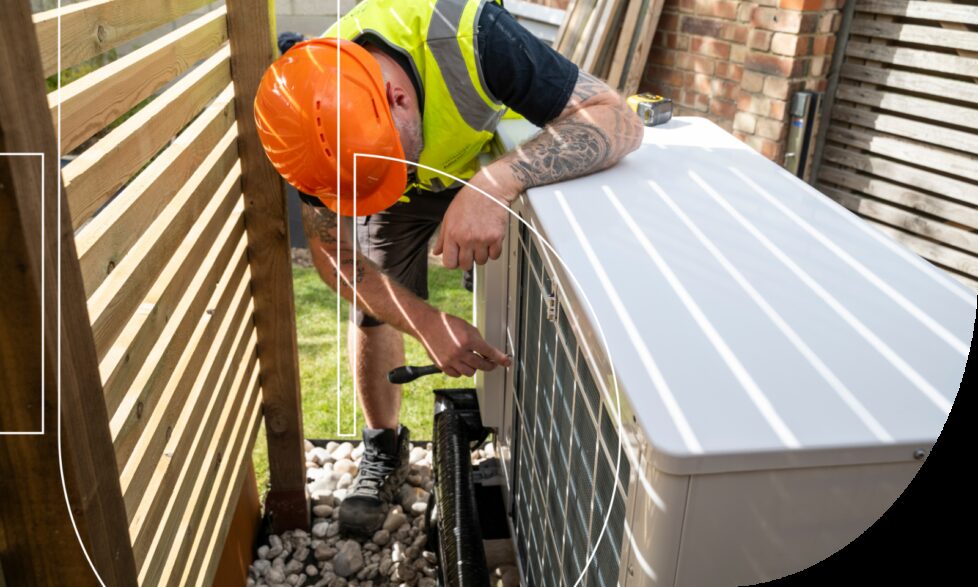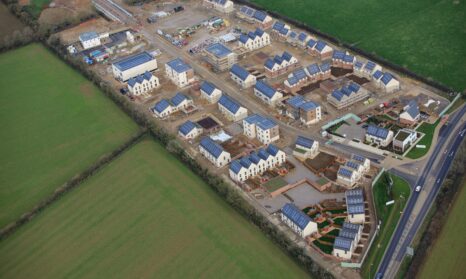How heat pump-ready is the UK?
With around 40% of the UK’s carbon emissions coming from the built environment, decarbonising our heating and retrofitting the UK’s old, leaky housing stock will be absolutely crucial to achieving our legally-binding climate targets.
But within the sector, there are a range of differing opinions on how exactly it should be done – and in what order – from ‘fabric first’ (prioritising improvements to the energy performance of a building's structure) through to ‘fabric fifth’ (where energy-saving measures such as heat pumps can come much earlier).
From my experience as Energy and Carbon Specialist at Bioregional, there’s no one-size-fits-all answer – it depends on the exact context and needs of a region. To answer the question comprehensively, I’ll examine how heat pump-ready the UK is through 3 lenses:
- housing stock/age
- the UK’s differing climate regions
- primary substation capacity
But first: defining ‘heat pump-ready’
So, how exactly do we label a UK home as being ‘heat pump-ready’? More often than not, it’s a local authority assessment of housing stock in a particular area, which decides based on dwelling size, age, fabric performance, available outside space and electrical service connection, establishing simply whether the homes could accommodate a standard domestic monobloc heat pump (14kWth).
Examining the UK’s housing stock
In principle, the approach above could be useful in speeding up the roll-out of heat decarbonisation, and it could incentivise the development of Distribution Supply Operators and renewable-centred microgrids. The studies in Surrey and Cornwall show positive results in terms of heat pump readiness. We know from the data that where the policy is implemented, the supply chain follows (talking about heat pumps specifically).
For context, here’s a quick summary of the Cornwall and Surrey guides. As well as highlighting those homes which are deemed heat pump-ready, they also highlight the age and size of homes which need retrofitting.
Roughly these equate to:
- Cornwall: out of the roughly 120k homes in the study, around just 30% of houses need fabric improvements, ranging from minor to major. These tend to fall into the following categories:
- 100-150m2 semi 1929 or earlier.
- 150-400m2 detached 1995 or earlier.
- Surrey: out of the 350k homes in the study, around 45% of houses need a range of fabric improvements. These tend to fall into the following categories:
- 70-150m2 terraced 1929 or earlier.
- 100-150m2 semi 1949 or earlier.
- 150-400m2 detached 1975 or earlier.
Regional climate is perhaps the determining factor here, given that a higher percentage in Cornwall are classed as heat pump-ready, as illustrated by Passivhaus Trust - something I’ll expand on later.
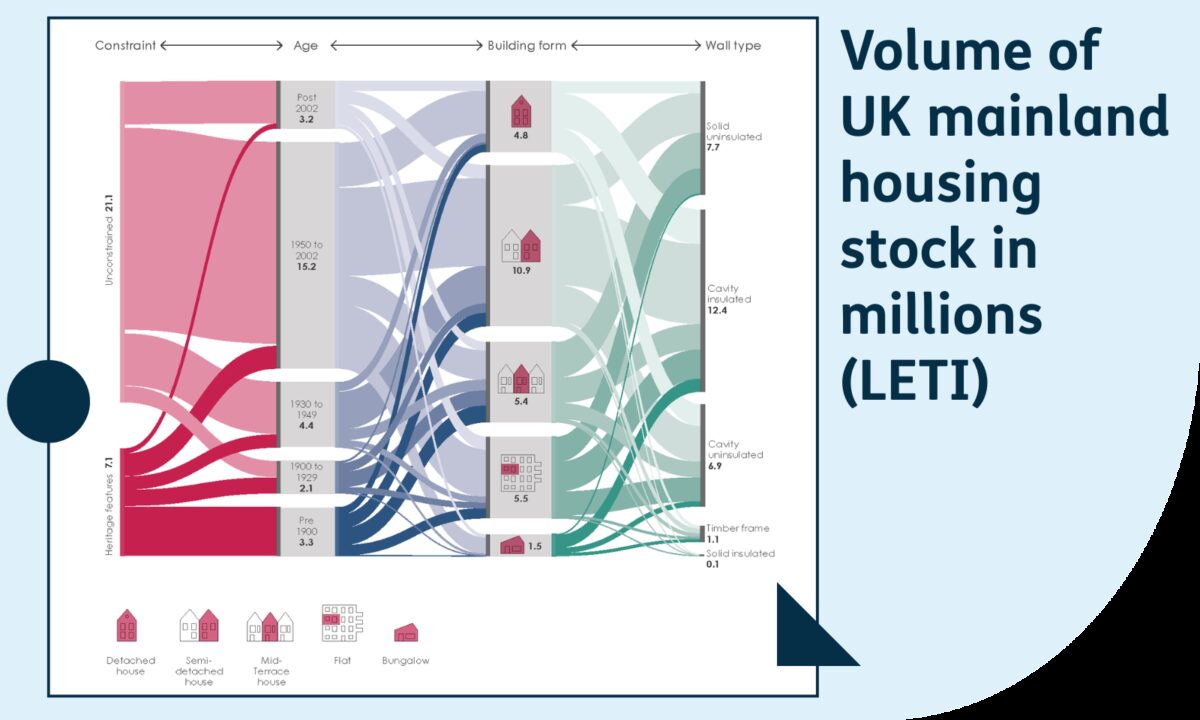
Within London Energy Transformation Initiative’s (LETI) retrofit guide, it suggests that out of the 28.2m dwellings across the UK, 3.3m were built before 1900 and 18.4m built after 1950.
Reviewing the latest census data for just England and Wales, there are over 26m homes, and the type and number reliant on gas are set out below.
| House Type | Total | Total Gas Heating |
|---|---|---|
| Detached | 6,008,190 | 4,200,195 |
| Semi Detached | 8,071,275 | 6,348,175 |
| Terraced | 6,072,890 | 4,703,540 |
| Flat/Maisonette | 6,061,360 | 3,010,705 |
The UK’s housing stock is quite evenly weighted between house types, with a large portion of detached and semi-detached properties on the gas network, and the geographical spread is pretty even (below).

So – this tells us two things. Firstly, the scale of the problem (and the potential for positive impact) is huge – excluding flats, there are over 15m homes on gas that have the physical space to accommodate a heat pump. And secondly, the problem is countrywide.
Is the UK’s electricity network ready for heat pumps?
If heat pumps were suddenly rolled out en masse, we’d be placing more than twice the diversified load on the UK’s existing electricity network that a typically gas-heated property would.
Speaking with utilities consultants on one of Bioregional’s recent projects, anecdotally, a typical gas-fired home typically demands 1.5kVA*, whereas heat pump homes have a demand of 3.5kVA - more than double.
LETI suggests (from a 2018 source) that peak load may be a critical constraint to rolling out heat pumps. It was estimated that the peak thermal load currently demanded by our homes and delivered by gas was 170GW, and the then electrical grid capacity was around 60GW, and even by 2050 is projected to only be 100GW.
A recent paper maps the Primary Substation (PS) network of the UK with publicly available data. (PSs are a crucial part of UK distribution networks and are at the lowest voltage level of 11kV.)
*After Diversity Maximum Demand (ADMD)

(This reference was pulled together by a multitude of spreadsheet datasets, but more recently this work on grid transparency has accelerated with the likes of UKPN openly providing this data on a searchable open-source platform, which is a great step forward.)
The impact of the UK’s different climate regions
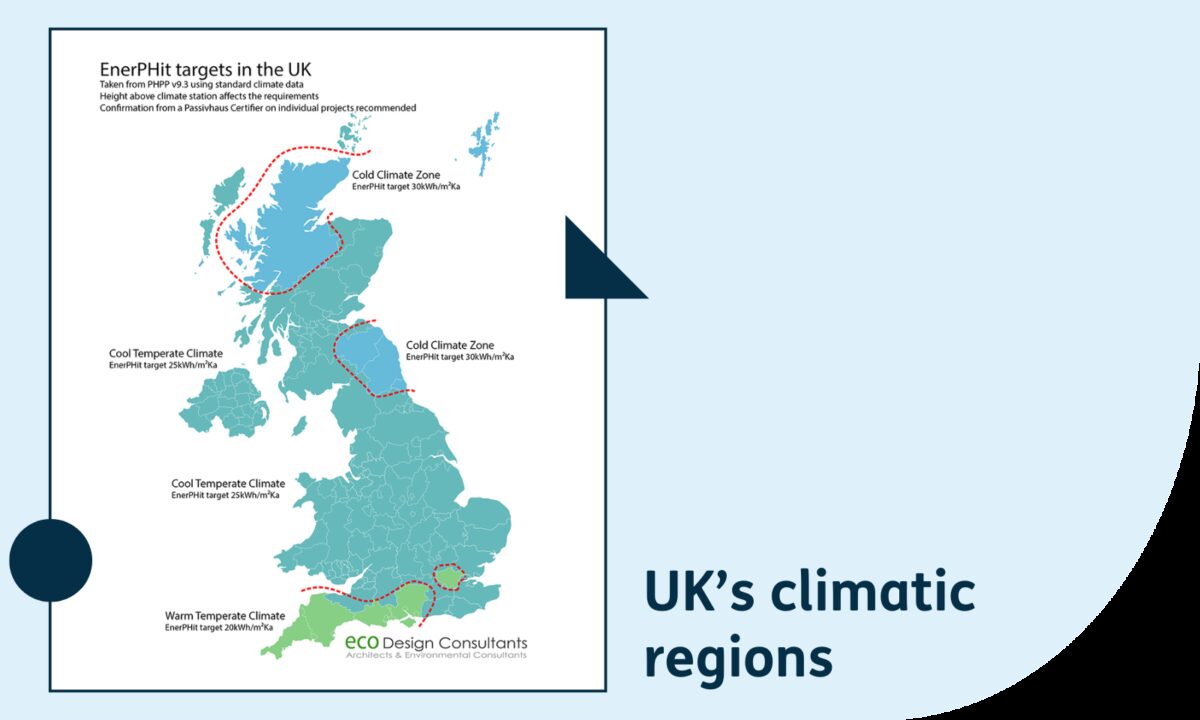
Across the UK, there are distinct areas where the climate is generally warmer or cooler, as illustrated by the Passivhaus Trust’s (PHT) illustration.
It’s worth highlighting that the Cornwall and Surrey readiness studies I mentioned earlier cover two areas that benefit from a slightly warmer climate, which reduces the anticipated peak heating load. For Cornwall, MCS-certified (Microgeneration Certification Scheme) heat pump systems typically use a design temperature of -1.5°C for the external air in Plymouth, while Birmingham is -5.1°C.
I should also state that these studies are based on the current climate, so there must also be research into the resilience needed to cope with more extreme weather events, such as severe cold snaps that are to come due to climate breakdown - something which, in part, is solvable via fabric interventions to reduce demand. Warmer summers are also a concern - and a driver for heat pump uptake. From our recent housing visits in high-risk areas of the southeast, we’ve seen post-year 2000 houses where they have installed air-to-air heat pumps to solely provide cooling.
Bringing it all together: housing stock, climate, and grid capacity in a regional example
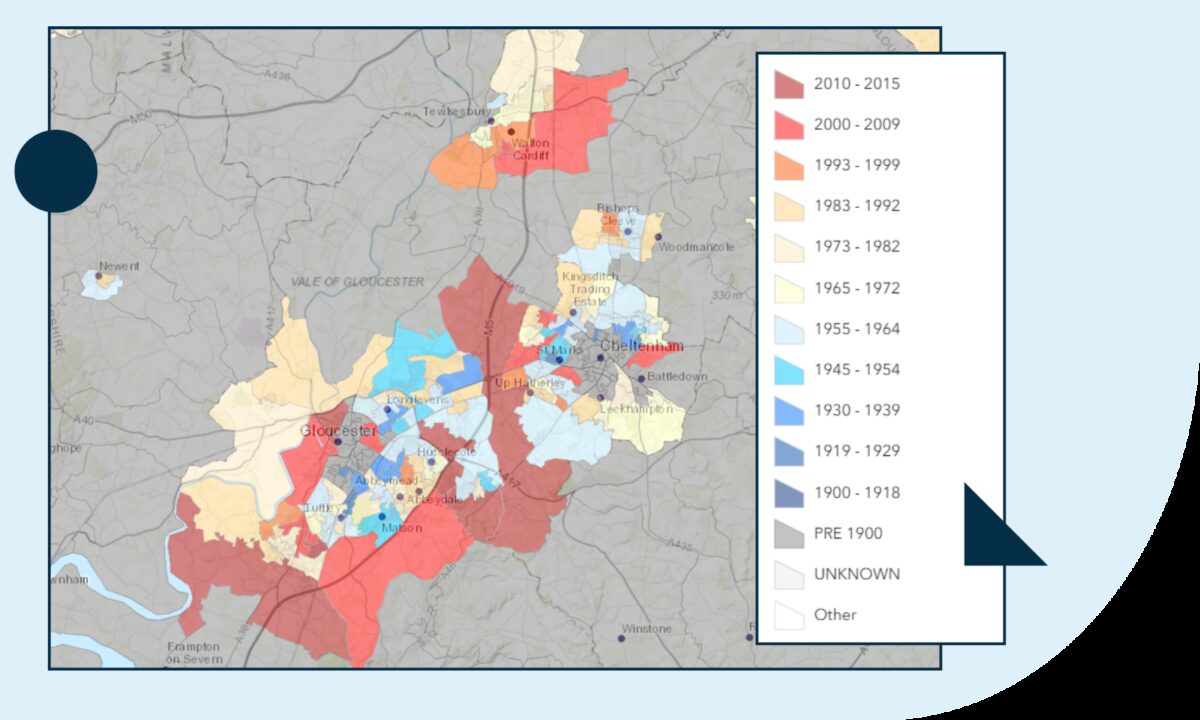
So, to make all of this tangible at a regional level, let’s zoom into a central UK area such as Gloucester, Cheltenham and Tewkesbury, the majority of which sits in a cooler part of the country.
Looking at local housing stock age using ArcGIS, we can see large swathes of new-ish development ripe for heat pump retrofit – the orange-red areas. However, when analysing the capacity of the local grid, we can see it’s already really saturated, with very limited capacity for extra load.

There are three substations in Gloucester City, five in Tewkesbury and two in Cheltenham. Out of the ten substations within the area, eight are designated as red, meaning they have the lowest connection potential. However, two substations are designated as green, so there is some potential for new generation to connect.
So, with this region as a micro example, it’d be a reasonable estimate that a lower percentage of housing stock is of an age, type and grid location that means it’s heat pump-ready.
And because of the areas where grid capacity is limited, a larger percentage of housing stock would benefit from a fabric-first, Passivhaus-level of retrofit, significantly reducing the need for any increased load on the grid.
And if you scale this up across the UK, you see the picture is mixed: a patchwork of ready and non-ready homes and substations across every region – nowhere is exempt.
So… is the UK heat pump-ready?
You’ve no doubt guessed the short answer: not yet.
The research and studies in Cornwall and Surrey offer valuable insights, but they only begin to scratch the surface. To truly prepare the UK for heat pump deployment at scale, we need to tackle the real issues head-on:
- Clear mapping of regions with older homes, weaker grids, and colder climates that pose barriers.
- Targeted local policies to incentivise both fabric retrofits and heat pump adoption.
- Grid upgrades to handle the increased electrical demand.
Heat pumps are essential for decarbonising our homes, but they’re not a magic bullet. Without addressing fabric inefficiencies and grid constraints, we risk creating a frustrating, costly, and ultimately failed rollout.
What good is a heat pump in a cold, drafty house with a grid that can’t support it, while it costs the occupant more than their previous fossil fuel boiler? If we don’t rethink how and where we deploy heat pumps, we’ll be left with nothing but expensive failures and no viable backup for our climate goals.
In the recent House of Commons report, Retrofitting homes for net zero, Joanne Wheeler, Co-Head of Policy & Places, UK Green Building Council, stated that “while a coordinated, national retrofit strategy is necessary, it should be delivered with local authorities and communities who better understand the local housing stock, demographics, supply chain and workforce” - and I agree.
It’s time for a strategic, data-driven approach. Only then will the UK be ready for a true heat pump revolution.
How Bioregional can help your local authority

We're experts at helping local authorities break daunting sustainability challenges into achievable, collaborative steps, and we bring decades of diverse, multi-sector experience to the table. This gives us rare breadth, depth and agility to adapt to your exact project and needs. View our full range of support here.
If this blog resonated with you, we’d love to help you identify the areas of your region that are heat pump-ready, as well as where the housing is older and the grid is weaker. Our team can highlight the opportunities and risks for retrofit, and where policy can be implemented to generate heat pump uptake, as well as fabric improvements tailored to each region.
We’ve recently been appointed by South Cambridgeshire District Council for a project funded by the Cambridgeshire and Peterborough Combined Authority to develop a retrofit guide covering housing archetypes in the region. This will build upon our Cambridge City retrofit guide and will focus on heat pump readiness across the region, housing stock modelling, and it will expand into broad regional mapping.
We'll be evaluating regional substation constraints, estimating the carbon emissions of each region, assessing the impact of heat pump-ready retrofit and highlighting the residual emissions of those homes requiring a deep/ideal retrofit and heat pump due to age or size. This will help demonstrate to homeowners the impact they could collectively have across the region through home energy efficiency improvements, as well as improving health, comfort and reducing energy bills.
Interested in something similar for your area? Get in touch below.
About the author
Say hello
Discover how we can support your local authority
-
Beyond compliance
-
Never cookie-cutter
-
Enablers not theorists

Thank you
We'll be in touch within two working days




